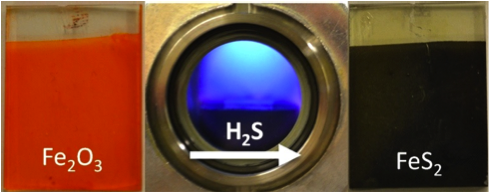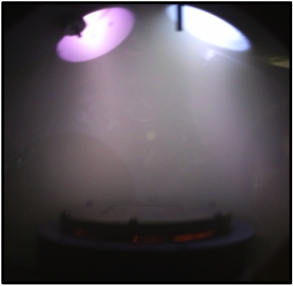Earth Abundant Materials for Solar Energy Conversion
The low intensity and variable nature of solar energy requires that the technologies used to harness this renewable
resource must be scalable and employ materials that are low cost and abundant. In these completed projects we developed plasma-assisted
processes to synthesize chalcogen-based materials as potential candidates for next generation solar absorbers and catalysts for water splitting.
Pyrite (Fool’s Gold)
Pyrite, FeS2, is a non-toxic, earth abundant semiconductor that offers promise for sustainable energy
applications. Its high theoretical specific energy capacity (~1300 Wh/kg) makes it an attractive material to serve
as the cathode in Li ion batteries, while its large absorption coefficient (> 105 cm-1) and
optical band gap of ~0.95 eV make it a candidate for ultrathin solar cells. Our group developed two novel
plasma-assisted processes for the synthesis of pyrite thin film. In the first process an iron oxide film was exposed
to a flow of H2S which is dissociated by a plasma into its elemental constituents. Under these conditions
it is thermodynamically favorable for atomic sulfur to replace oxygen, enabling direct conversion of hematite into pyrite.
In the second approach discrete layers of FeS2 were deposited sequentially at rate of ~1 Å/cycle using a
technique called pulsed plasma-enhanced chemical vapor deposition (PECVD) using mixtures of Fe(CO)5 and
H2S. This is a self-limiting technique and is analogous to ALD in that discrete amounts of material are
deposited with each plasma pulse.
 Two-dimensional (2D) metal
dichalcogenides (WS2, MoS2, etc.) are molecularly thin sheets that have exhibited extraordinary
optical properties, catalytic performance, and electronic structure. We have extended the plasma-assisted synthesis
techniques developed for pyrite to these materials systems and are exploring their potential as catalysts for
photoelectrochemical production of hydrogen.
Two-dimensional (2D) metal
dichalcogenides (WS2, MoS2, etc.) are molecularly thin sheets that have exhibited extraordinary
optical properties, catalytic performance, and electronic structure. We have extended the plasma-assisted synthesis
techniques developed for pyrite to these materials systems and are exploring their potential as catalysts for
photoelectrochemical production of hydrogen.
 The plasma-assisted fabrication
of
these chalcogen semiconductors was supported by the National Science Foundation through Award No. DMR-1207294.
The plasma-assisted fabrication
of
these chalcogen semiconductors was supported by the National Science Foundation through Award No. DMR-1207294.
Rapid Development of Earth-Abundant Thin Film Solar Cells
 This project was part of a larger,
collaborative effort with NREL that was lead by Dr. Andriy Zakutayev. The goal of this project was to expand the
paradigm for thin film solar cells by accelerating the development of new materials with high potential for solar
energy conversion. PhD graduate Adam Welch used combinatorial sputtering approaches to rapidly explore the Cu-Sb-S
phase space and develop processing conditions that yield phase pure ternary alloys such as CuSbS2 that show promise
as alternatives to copper indium gallium diselenides (CIGS).
This project was part of a larger,
collaborative effort with NREL that was lead by Dr. Andriy Zakutayev. The goal of this project was to expand the
paradigm for thin film solar cells by accelerating the development of new materials with high potential for solar
energy conversion. PhD graduate Adam Welch used combinatorial sputtering approaches to rapidly explore the Cu-Sb-S
phase space and develop processing conditions that yield phase pure ternary alloys such as CuSbS2 that show promise
as alternatives to copper indium gallium diselenides (CIGS).
This work was supported through the SunShot initiative by the U.S. Department of Energy, Office of Energy Efficiency and Renewable Energy under Contract No. DE-AC36-08GO28308.


